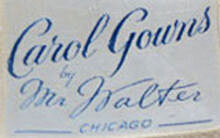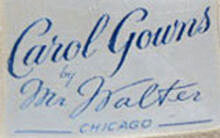After WWII Mr. Walter Nagel was to go to work as an electrical engineer. After a trip to Chicago he liked it there so much that he stayed and took a temp job selling lace. He knew nothing about lace but needed the job, so he learned the names of the lace and went store to store. An owner of a bridal shop informed him that since the war had ended there was a tremendous need for ready-made wedding gowns. He told the woman he had a friend in New York from whom he could get gowns from for a good price but they would all be the same style. The owner was thrilled to get them, telling Walter she could change the sleeves, neckline, and train to each girl’s taste. They sold within days and she asked Walter to get her more gowns. He phoned his friend in NYC and when the “friend “ learned how quickly they were selling, he doubled the price. Walter said he told him,“Forget you” and he decided to open his own bridal and formal gown factory right after that phone call.
While selling the lace he had become friendly with the owners of Blume and Lybeck (the oldest bridal/formal wear factory in Chicago) and they helped him, giving him cutting tables and telling him where to buy machines and hire seamstresses, as they had trouble meeting the demand nationwide.
After WWII there was a garment district in Chicago as in NYC (his factory was, it is believed, at 208 S. Jefferson) Walter knew nothing about running a factory but he said he was determined to be his own boss. He was his own salesman, driving all over the USA, and sleeping in his car because he could not afford a hotel room. He was a good salesman and loved what he did. He eventually hired salespeople and said he loved getting up every morning to go to the factory. He used to tease and say, “I want to be the best electrical engineer who ever designed and manufactured bridal and formal gowns!”
Carol Gowns were named after his first wife and the signature on the label is his actual signature.
Written by Meg Nagel

